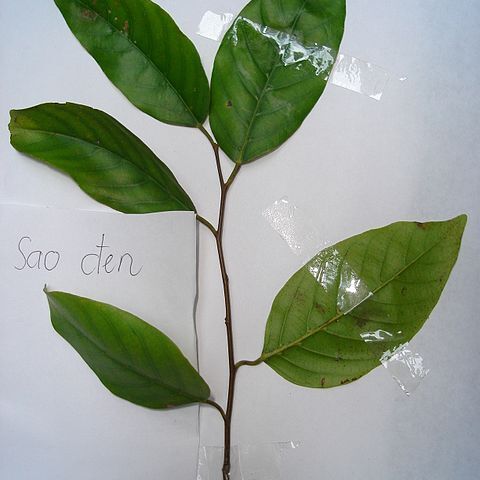Small to large usually resinous mostly buttressed trees; indumentum various but often of fasciculate hairs, frequently glandular. Leaves alternate, simple, entire or sinuate at margin; stipules paired, large or small, persistent or soon falling. Flowers ?, regular, in axillary or terminal branched panicles, racemose or less often cymose; bracts and bracteoles paired, persistent or soon falling. Calyx persistent; lobes imbricate or valvate, free or fused at the base; 2–5 lobes usually accrescent into very distinct wings in fruiting state. Corolla-lobes 5, contorted, connate at base or free. Stamens 5 to over 100; filaments free or connate; anthers 2-thecous, introrse or laterally dehiscent. Ovary superior or semi-inferior, partly unilocular or (2–)3–5-locular (4 in the sole S. American genus); ovules 2(–4) in each locule, axile or parietal. Fruit indehiscent, usually 1-seeded with woody pericarp, usually with 2–5 persistent wing-like sepals but not accrescent in a few genera
Leaves alternate, entire, penninerved; indumentum often of two kinds, of stellate hairs or rarely of peltáte scales; stipules mostly small and deciduous, sometimes very large and enclosing the young bud, rarely persistent, leaving an annular scar after falling away
Calyx-tube short or well developed, free or adnate to the ovary; lobes 5, imbricate or valvate, mostly greatly enlarged, wing-like, and ascending in fruit and then strongly nervose, rarely small and reflexed or spreading
Stamens rarely definite, hypogynous or subperigynous; filaments short, often dilated at the base; anthers 2-celled, opening lengthwise; connective mucronate or aristate or club-shaped
Leaves alternate, petiolate, entire, penninerved, in African species always with an extra-floral nectary at the base of the midrib on the upper face of the lamina; stipules caducous
Ovary inserted on the broad torus or slightly immersed in it, 3-celled; style subulate or variously thickened, entire or 3-lobed; ovules 2 in each cell
Fruit free from or included in the enlarged calyx-tube, rarely closely adnate to it, indehiscent, usually 1-seeded
Fruit 1-seeded, indehiscent, surrounded by the wings (always 5 in the African species) of the accrescent calyx
Petals 5, much contorted, free or slightly connate at the base, often hairy and inconspicuous
Ovary superior, (1) 3-locular with axile or parietal placentation; carpels (1) 3, 2-ovulate
Seeds without endosperm; cotyledons thick and equal or variously contorted
Petals 5, contorted to the right, free or slightly connate at the base
Flowers hermaphrodite, actinomorphic, fragrant, in axillary panicles
Stamens 5, 10, 15 or numerous (always numerous in African species)
Flowers actinomorphic, bisexual
Trees with resinous wood
Sepals 5, accrescent
Trees or shrubs


